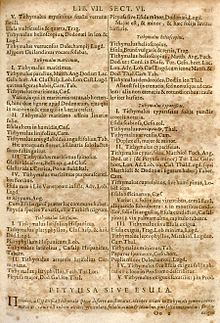Gaspard Bauhin
Gaspard Bauhin | |
|---|---|
M.D., 1581) | |
| Known for | Pinax theatri botanici |
| Scientific career | |
| Fields | Botany |
| Notable students | Emmanuel Stupanus |
| Author abbrev. (botany) | C.Bauhin |
Gaspard Bauhin or Caspar Bauhin (
botanist whose Pinax theatri botanici (1623) described thousands of plants and classified them in a manner that draws comparisons to the later binomial nomenclature of Linnaeus. He was a disciple of the famous Italian physician Girolamo Mercuriale and he also worked on human anatomical
nomenclature.
Linnaeus honored the Bauhin brothers Gaspard and Jean in the genus name Bauhinia.[1]
Biography

Jean and Gaspard were the sons of
Greek professorship at the same university, as well as in 1588 to the chair of anatomy and botany.[2] He was later made city physician (Stadtarzt), professor of the practice of medicine, rector of the university, and dean of his faculty.[3] He was rector of the university of Basel in 1592, then again in 1611 and 1619; during the second rectorate the university tried in vain to win back from the city council the freedoms of 1460, which were lost in 1532.[4]
The Pinax theatri botanici (English, Illustrated exposition of plants) is a landmark of
grasses, legumes, and several others. His most important contribution is in the description of genera and species. He introduced many names of genera that were later adopted by Linnaeus, and remain in use.[2] For species he carefully pruned the descriptions down to as few words as possible; in many cases a single word sufficed as description, thus giving the appearance of a two-part name. However, the single-word description was still a description intended to be diagnostic, not an arbitrarily-chosen name (in the Linnaean system, many species names honor individuals, for instance).[citation needed
]
In addition to Pinax Theatri Botanici, Gaspard planned another work, a Theatrum Botanicum, meant to be comprised in twelve parts folio, of which he finished three; only one, however, was published (1658), long after his death. He also gave a copious catalogue of the plants growing in the environs of Basel, its
Works

- (as editor), Petri Andreae Matthioli Opera Omnia, Johannes König, Basel, 1574.
- Theatrum anatomicum infinitis locis auctum, ad morbos accommodatum, Basel, 1592.
- Theatrum Anatomicum, Frankfurt am Main, 1605.
- Phytopinax seu enumeratio plantarum (in Latin). Basel. 1596.
{{cite book}}: Unknown parameter|agency=ignored (help) - Anatomica corporis virilis et muliebris historia, Leiden, 1597.
- Animadversiones in historiam generalem plantarum (in Latin). Frankfurt am Main. 1601.
{{cite book}}: Unknown parameter|agency=ignored (help) - Prodromos theatri botanici (in Latin). 1620. The introduction to his projected magnum opus.
- Prodromos theatri botanici (in Latin). Basel. 1671.
{{cite book}}: Unknown parameter|agency=ignored (help)
- Prodromos theatri botanici (in Latin). Basel. 1671.
- Pinax theatri botanici, Basel, 1623.
- Pinax theatri botanici (in Latin). Basel. 1671.
{{cite book}}: Unknown parameter|agency=ignored (help)
- Pinax theatri botanici (in Latin). Basel. 1671.
- Vivae imagines partium corporis humani (in Latin). Frankfurt am Main. 1640.
{{cite book}}: Unknown parameter|agency=ignored (help) - Theatrum Botanicum, 1658.
- Histoire des plantes de l’Europe, et des plus usitées qui viennent d’Asie, d’Afrique, & de l’Amérique […], 2 voll., Lyon, 1671.
See also
References
- ^ OCLC 8591273.
- ^ OCLC 947193619.
- ^ a b Chisholm 1911.
- ^ "Bauhin Caspar". University of Basel.
- ^ International Plant Names Index. C.Bauhin.
- This article incorporates text from a publication now in the public domain: Chisholm, Hugh, ed. (1911). "Bauhin, Gaspard". Encyclopædia Britannica. Vol. 3 (11th ed.). Cambridge University Press. p. 539.
External links
- University of Kyoto Online Pinax theatri botanici (1623)
- Online Galleries, History of Science Collections, University of Oklahoma Libraries High resolution images of works by and/or portraits of Gaspard Bauhin in .jpg and .tiff format.
- Images from Theatrum anatomicum From The College of Physicians of Philadelphia Digital Library
- Caspari (Gaspard) Bauhini, Prodromos Theatri Botanici (1620) Digitized Copy on Archive.org


